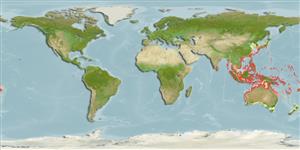Environment: milieu / climate zone / Tiefenbereich / distribution range
Ökologie
seewasser riff-verbunden; tiefenbereich 10 - 35 m (Ref. 11890). Tropical
Western Pacific: Japan, Taiwan, and Papua New Guinea (Ref. 11890).
Size / Gewicht / Alter
Geschlechtsreife: Lm ? range ? - ? cm
Max length : 14.0 cm TL Männchen/unbestimmt; (Ref. 559)
Rückenflossenstacheln (insgesamt) : 7; Rückenflossenweichstrahlen (insgesamt) : 9; Afterflossenstacheln: 2; Afterflossenweichstrahlen: 8. Body light-yellow and anterior margin of scales dark. Attains 14 cm SL.
Body shape (shape guide): short and / or deep; Cross section: compressed.
Inhabits coral reef (Ref. 75154).
Life cycle and mating behavior
Geschlechtsreife | Fortpflanzung | Ablaichen | Eier | Fecundity | Larven
Mouthbrooders (Ref. 240). Distinct pairing during courtship and spawning (Ref. 205).
Masuda, H., K. Amaoka, C. Araga, T. Uyeno and T. Yoshino, 1984. The fishes of the Japanese Archipelago. Vol. 1. Tokai University Press, Tokyo, Japan. 437 p. (text). (Ref. 559)
IUCN Rote Liste Status (Ref. 130435: Version 2025-1)
Bedrohung für Menschen
Harmless
Nutzung durch Menschen
Tools
Zusatzinformationen
Download XML
Internet Quellen
Estimates based on models
Preferred temperature (Ref.
123201): 23.6 - 29, mean 28 °C (based on 380 cells).
Phylogenetic diversity index (Ref.
82804): PD
50 = 0.5000 [Uniqueness, from 0.5 = low to 2.0 = high].
Bayesian length-weight: a=0.01445 (0.00680 - 0.03071), b=3.07 (2.89 - 3.25), in cm total length, based on LWR estimates for this (Sub)family-body shape (Ref.
93245).
Trophic level (Ref.
69278): 3.6 ±0.5 se; based on size and trophs of closest relatives
Widerstandsfähigkeit (Ref.
120179): hoch, Verdopplung der Population dauert weniger als 15 Monate. (Preliminary K or Fecundity.).
Fishing Vulnerability (Ref.
59153): Low vulnerability (10 of 100).
🛈
Nutrients (Ref.
124155): Calcium = 109 [56, 170] mg/100g; Iron = 0.832 [0.494, 1.383] mg/100g; Protein = 18.7 [17.5, 19.8] %; Omega3 = 0.125 [0.075, 0.202] g/100g; Selenium = 30.9 [16.9, 57.6] μg/100g; VitaminA = 59.2 [17.9, 195.2] μg/100g; Zinc = 1.46 [0.98, 2.10] mg/100g (wet weight);
